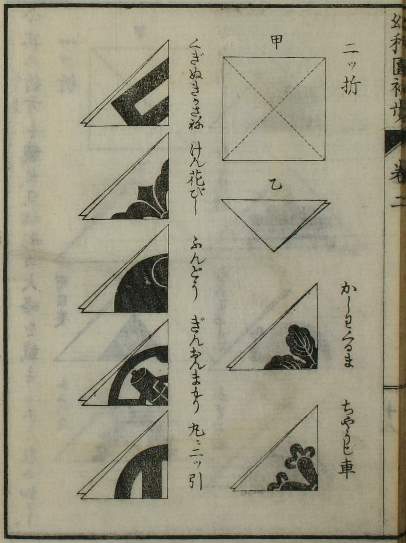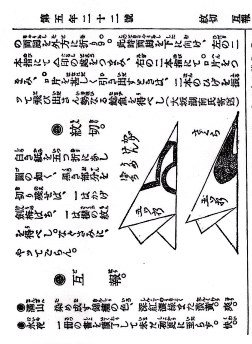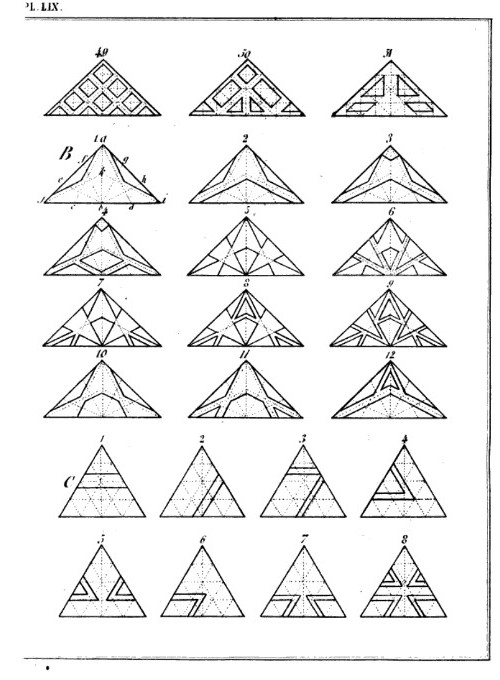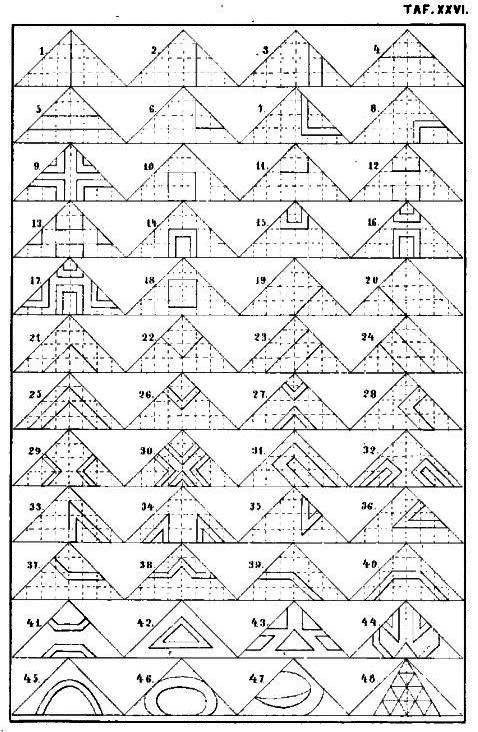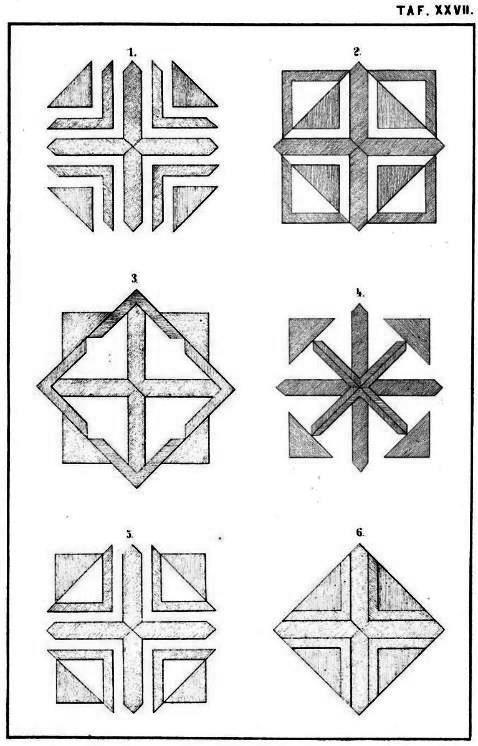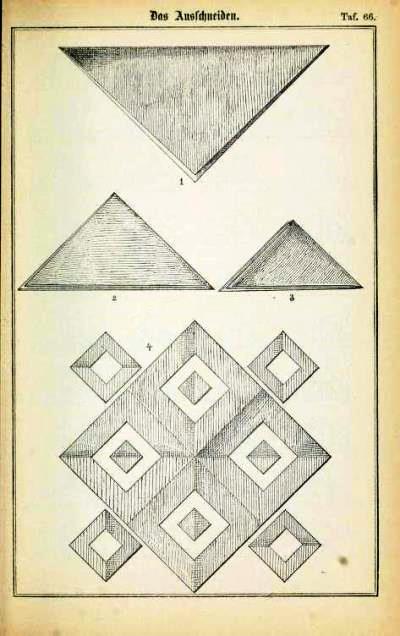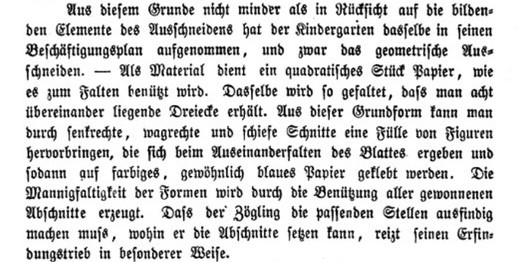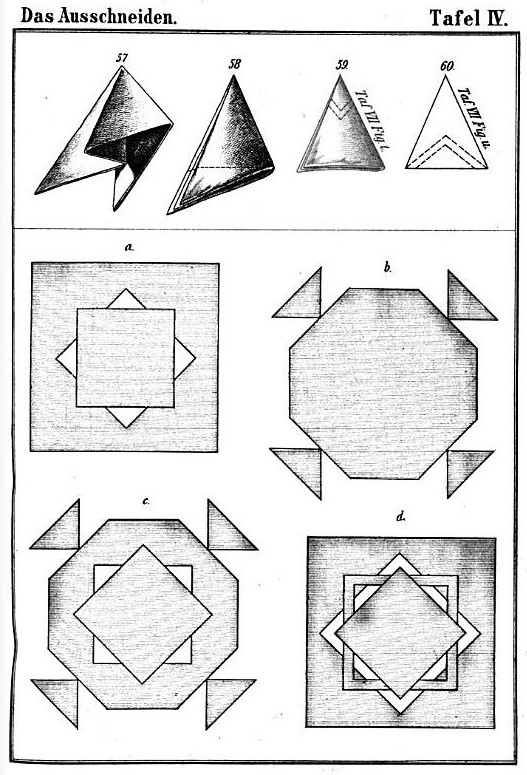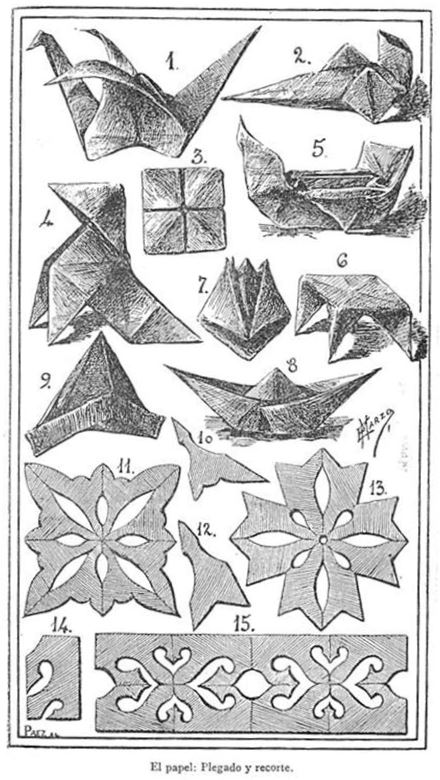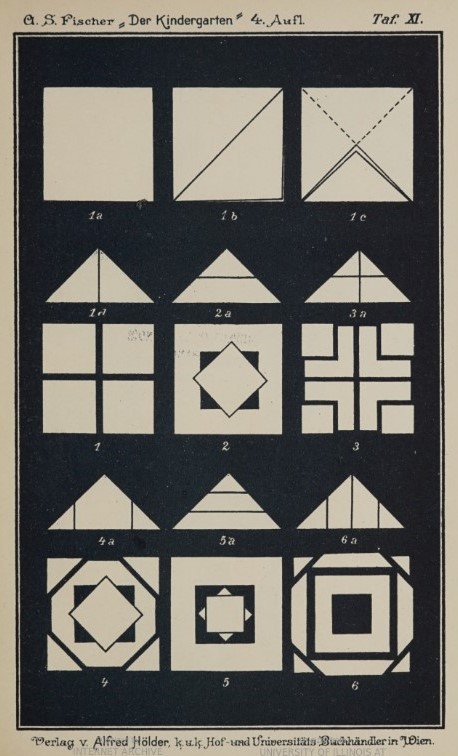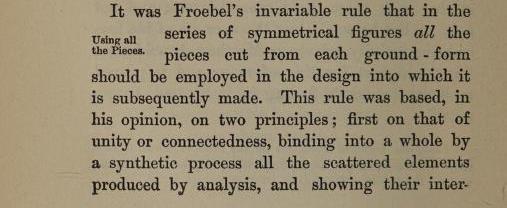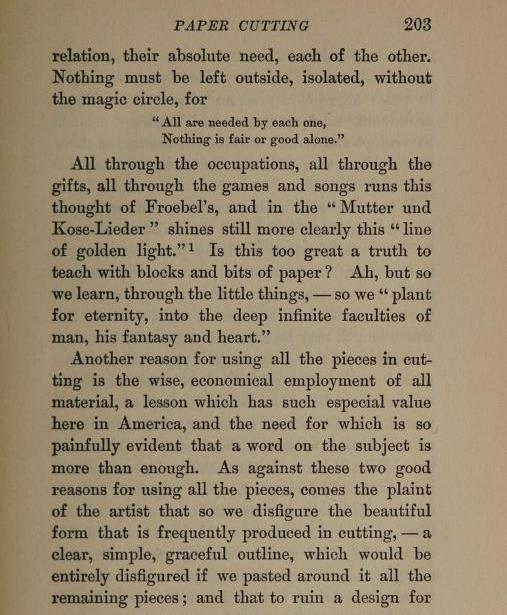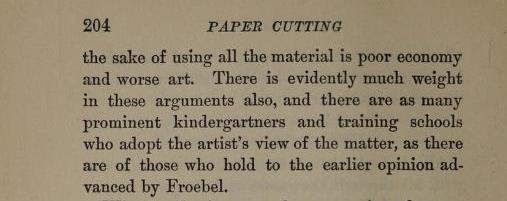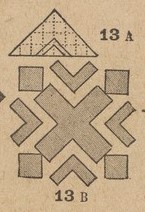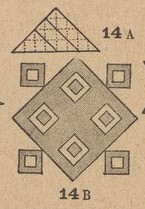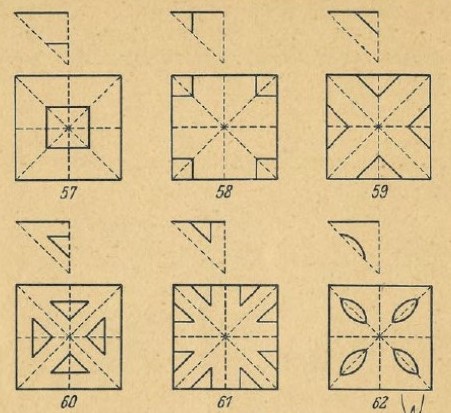| The Public Paperfolding History Project
Last updated 15/10/2025 x |
|||||||
| The Froebelian Occupation of Ausschneiden und Aufkleben (Cutting Out and Mounting) | |||||||
| This
page is being used to collect information about the
history of the Froebelian occupation of Ausschneiden und
Aufkleben (Cutting Out and Mounting), most probably
invented by Froebel himself, in which the paper is first
folded, then cut, then opened out. Both the main piece of
paper and, in accordance with the principle that nothing
must be wasted, any other pieces separated by the cuts,
are then mounted on paper or board to create a pattern. The original occupation was based on squares folded into 8-layer right angle isosceles triangles. The occupation was quite quickly expanded to include designs made from hexagons folded into 6-layer equilateral triangles and then to octagons folded into 8-layer isosceles triangles. I have recorded instances of fold and cut / tear designs on this page irrespective of whether the result is mounted together with the separated pieces in the original manner or not. This occupation seems to have gradually fallen out of use after 1900. I have not made a detailed study of this occupation or the various patterns of cuts used. ********** In Japan (and in books by Japanese authors) 1885 Several pages of instructions for folding and cuttingout symmetrical patterns appear in 'Kindergarten Shoho' (Preliminary Kindergarten) by Iijima Hanjuro, which was copyrighted on October 4th Meiji 17 (1884) and published by Fukuda Senzo in August of Meiji 18 (1885).
********** 1892 'Kani Shukogaku' (Simple Handicraft) by Tamotsu Shibue, which was published in Tokyo in 1892, also contains pages of symmetrical fold and cut designs. ********** 1893 Volume 5 issue 22 of the Japanese children's magazine 'Shokokumin' contains a brief section showing how to cut out two symmetrically rotational designs.
********** 1903 Several pages of instructions for making symmetrical fold and cut designs appear in 'Jinjo Kouto Shogaku Shuko Seisakuzu' (Handicrafts for ordinary higher elementary schools) by Hideyoshi Okayama was published by Rokushiro Uehara in Tokyo in 1903, although these are not clearly Froebelian in nature. ********** 1951 Several pages opf patterns for symmetrical paper cuts appear in 'Origami to Kirinuki' by Saburo Ueda, which was published by Kokkado in Tokyo, most probably in 1951. ********** In Europe and the Americas 1855 The earliest explanation of this occupation that I know of can be found in 'A Practical Guide to the English Kinder Garten' by Joh and Bertha Ronge, which was published by Hodson and Son in London in 1855. It contains several plates which show ways of cutting designs from squares which have been folded into eight layer silver triangles but also mentions / illustrates the possibility of more complex designs achieved by free-cutting. It is also notable for the statement:
**********
********** 1856/7 There is information about Auschneiden und Aufkleben in both parts of 'Bilderswerkstatt als Arbeitsubung fur die Jugend in Schule und Haus' by Jan Daniel Georgens which were published in 1856 and 1857 respectively. ********** 1859 'Manuel pratique des jardins d'enfants de Frédéric Froebel', which was compiled by J F Jacobs and published by F Claassen in Brussells and L Hachette and Cie in Paris in 1859, also contains several plates which show ways of cutting designs into squares which have been folded into eight-layer silver triangle but also shows examples of designs that can be made from hexagons folded into 6-layer equilateral triangles..
********** Information about Ausschneiden und Aufkleben / Cutting Out and Mounting also appears: 1860 In an article in 'Jardines de Infancia' by Mariano Carderera in 'Anales de Primera Ensenanza. Periodico de las escuelas y de los maestros' (Annals of Primary Education: Periodical for Schools and Teachers) published in Madrid in 1960, which summarised the material found in 'Manuel Pratique des Jardin D'Enfants de Frédéric Froebel' but without reproducing the illustrations. ********** 1861 In 'Das Paradies der Kindheit' (The Paradise of Childhood) by Lina Morgenstern, which was published in Leipzig in 1861. ********** 1863 In 'De Kleine Papierwerkers: Volume 4: Het Knippen en plakken' (Cutting and Pasting) by Elise Van Calcar and published by K H Schadd in Amsterdam in 1863. ********** In 'Moral Culture of Infancy and Kindergarten Guide' by Mrs Horace Mann (Mary Tyler Peabody) and Elizabeth P Peabody, which was published by T O H P Burnham in Boston in 1863. ********** 1869 In 'Der Kindergarten' by Hermann Goldammer, which was published by Habel in Berlin in 1869. ********** In 'Paradise of Childhood' by Edward Wiebe, which was published by Milton, Bradley and Company in Springfield, Massachusetts in 1869 ********** In the second edition of 'Moral Culture of Infancy and Kindergarten Guide' by Mrs Horace Mann (Mary Tyler Peabody) and Elizabeth P Peabody, which was published by J W Schemerhorn and Co in New York in 1869. The most interesting reference in this work is probably the statement 'I have seen, in one of the Kindergartens, five hundred different figures made out of the simple square, variously folded and cut.' ********** 1873 In 'Exercices et Travaux pour les Enfants Selon la Méthode et les Procédés de Pestalozzi et de Froebel' by Fanny and Charles Delon, which was published by Librairie Hachette in Paris in 1873. ********** In 'Die Praxis Des Kindergartens' by August Koehler, which was published by Herman Bohlau in Weimar in 1873.
********** 1874 In the revised and updated third edition of 'Der Kindergarten' by Hermann Goldammer, which was published by Carl Babel in Berlin in 1874. ********** In 'Spiel und Arbeit' by Hugo Elm, which was published by Verlag und Drud der Otto Spamer in Leipzig in 1874.
********** 1875 Symmetrical cut and fold designs from both square and hexagonal paper appear in 'Froebels Methode' by Elise Van Calcar, which was published in 1875. ********** 1877 In 'Froebel's Plane Surfaces', the second part of 'Kindergarten Practice' by Mary Gurney, which is a substantially abridged version of parts of 'Die Praxis Des Kindergartens' by Auguste Koehler. The date of the first edition is not known. The second edition was published in 1877 in London by A N Myers and Co. ********** 1879 In 'Manual Teorico-Practico de Educacion Parvulos' by D Pedro de Alcantara Garcia, which was published in Madrid by the Imprenta del Colegio Nacional de Sordo-mudos y de Ciegos in 1879. ********** 1882 In Part 2 of 'The Kindergarten Guide' by Maria Kraus Boelte and John Kraus, which was published by E. Steiger and Company in New York in 1882. ********** 1883 In 'Der Kindergarten' by A S Fischer, which was published by Alfred Holder in Wien in 1883, the author gives an explanation of Froebel's occupation of Ausschneiden und Aufkleben including that all pieces should be used in the mounting phase but does not give details of any individual designs. Instead he prefers to concentrate on the free-cutting of simple symmetrical shapes, first following pre-drawn outlines and then freehand. The paper is NOT folded in half to help the pupils achieve symmetry.
********** 1887 In part 2 of 'Theoretisches und praktisches Handbuch der Fröbelschen Erziehungslehre' by Bertha von Marentholtz-Bülow, which was published by George H Wigand in Kassel in 1887. The section on Das Ausschnieden includes designs to be cut from an octagon folded into an 8-layer isosceles triangle.
********** In 'Primary Methods: A Complete and Methodical Presentation of the Use of Kindergarten Material in the Primary School' by W N Hailmann, which was published by A S Barnes and Company in New York and Chicago in 1887. The author bgins with a simplified method made by folding the square in half and half again before going on to explain more complex designs. ********** 1889 In Part 1 of 'Hand-And-Eye Training' by George Ricks which was published by Cassell and Company Ltd in London, New York and Melbourne in 1889. ********** In 'Royal Gifts for the Kindergarten' by Frances Post Van Norstrand and Alice H Putnam, which was published by the Standard Publishing Company in Chicago in 1889. ********** In 'Jeux et Travaux Enfantins - Premičre partie: Le Monde en Papier' by Marie Koenig and Albert Durand, which was published by Librairie Classique A. Jeande in Paris in 1889 (where the single fourfold pattern given is torn rather than cut from the paper). ********** 1890 In 'Le travail manuel a l'ecole et dans la famille' by MM, Bertrand, Toussaint and Gombert, which was published by Loucene, Oudin et ces Editeurs in Paris in 1890. ********** 1891 'Education of Head and Hand' by Gabriel Bamberger, which was published by A Flanagan in Chicago in 1891, is a compilation of six leaflets about manual work in schools. The third leaflet is about Froebel's occupation of Ausschneiden und Aufkleben, but, although it is surprisingly true to Froebel's original concept, the introduction for instance stating that the pieces cut off from the main design are to be used in the final mounted pattern 'to encourage thrift' ...
... no mention of the origin of this type of manual work is given. ********** 1892 'How to Teach Paper-Folding and Cutting' by Norma MacLeod, which was published by March Brothers in Lebanon, Ohio in 1892, contains Ausschneiden und Aufkleben designs, although without mentioning their Froebelian origin in any way. ********** 1893 In 'Cuestiones de Pedagogía Práctica Medios de Instruir' by D Vicente Castro Legua, which was published by Libreria de la Viuda de la Hernando y Ca in Madrid in 1893, although only two patterns created from a right angle isosceles triangle by this method are shown.
********** 'Practical Suggestions for Kindergartners, Primary Teachers and Mothers' by Jeannette R Gregory was published by C B Woodward and Co in St Louis in 1893. It provides a programme of work for each of the 40 weeks of the kindergarten year, many of which include paperfolding elements, including some examples of Ausschneiden und Aufkleben.
********** 1894 Designs cut from squares folded into quarters and from eight layered right angle isosceles triangles are also explained in 'Jeux et Occupations Pour les Petits: Guide des Mčres et des Institutrices' by Henriette Suzanne Brés was published by Librairie Classique Fernand Nathan in Paris in 1894, although the idea of using the pieces that have been cut away to complete the designs has disappeared. ********** 1895 The fourth (probably) edition of 'Der Kindergarten' by A S Fischer, which was published by Alfred Holder in Wien in 1895, contains an extra plate (Taf XI), which has been added to give visual examples of his description of Froebel's occupation of Ausschneiden und Aufkleben.
********** 1895 A sample book of Froebelian paperfolds and papercuts etc made by by Laura B Thompson in 1895 contains many exampes of Ausschneiden und Aufkleben designs.
********** 1896 'The Republic of Childhood', titled 'Froebel's Occupations', by Kate Douglas Wiggin and Nora Archibald Smith, which was published by Houghton, Mifflin and Company, of Boston and New York in 1896, contains a discussion about the use of cut off pieces in Ausschneiden und Aufkleben.
********** 1900 'What Shall We Do Now?' by Edward Verral Lucas and Elizabeth Lucas, which was published by Frederick A Stokes Company in New York in 1900, contains instructions for making a 'Paper Mat' with eight-fold symmetry from a square folded into an 8-layer right angle isosceles triangle.
********** 1900 'Introduccion a la Ensenaza Practica del Sistema de Kindergarten' by Ernesto Steiger, which was published by E Steiger and Co in New York in 1900. ********** Two examples of Ausschneiden und Aufkleben designs appear in 'Mes Jolie Jeux' by Henriette Suzanne Bres, which was published by Librairie Hachette in Paris in 1900.
********** 1910 There is a section devoted to simple 'Sterne' ie Ausschneiden und Aufkleben like forms in 'Allerlei Papierarbeiten' by Hildergard Gierke and Alice Kuczynski, which was published by Drud und Verlag B G Teubner in Leipzig and Berlin in 1910. ********** 1913 There are several pages of Ausschneiden und Aufkleben like designs in 'Trabajo Manual' by C Champy Alvear, which was published by Cabaut y Cia in Buenos Aires in 1913. ********** 1918 In 'Pasatiempos: Juegos Figuras Problemas Con Papel y Tigeras' (Games, Figures, Problems with Paper, Scissors), which was published by Editorial Muntanola in Barcelona, probably c1918.
********** 1936 'Allerlei Papierarbeiten' by Hilde Wulff and Carola Babick, which was published in Leipzig and Berlin in 1936, contains a section about 'Der Faltschnitt'. Although the author describes these forms as Schonheitsformen they are in fact simplified versions of Frobel's Aufschneiden und Aufkleben designs.
********** 1960 A section in 'Paper Folding Fun' by Robert Harbin, which was published by Oldbourne in London in 1960, explains many symmetrical designs made by cutting a folded sheet of paper in a way similar to thr Froebelian occupation of Ausschneiden und Aufkleben (Cutting Out and Mounting), (although without the 'Mounting' element), and without mentioning its origins. In fact the author implies that it is Japanese, the section beginning with the words 'In most Japanese books on this subject ...' ********** |
|||||||
